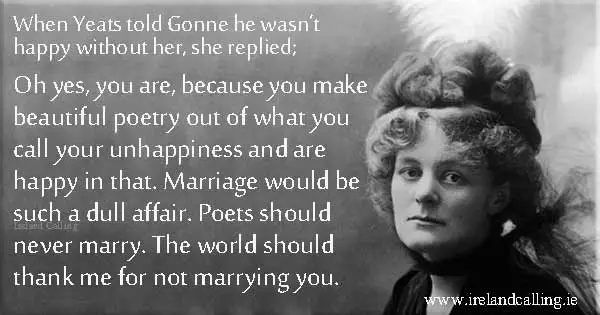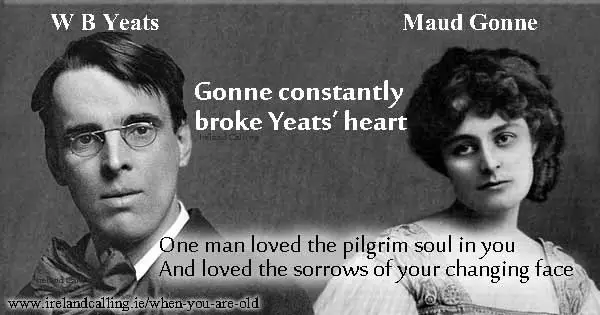William Butler Yeats is one of Ireland’s greatest poets and was a giant of the literary world in the late 19th and early 20th century.
He was awarded the Nobel Prize for Literature in 1923, which was the pinnacle of his career. He was a reserved academic who veered away from controversy.
Maud Gonne was a tall, beautiful and confident actress and a woman of considerable social standing. She was the daughter of an army officer and had been educated and raised in Paris, after her mother had died when Gonne was still very young. She had a daughter from a relationship she had with a French journalist and spent her time between Paris, Dublin and London.
Gonne was an Irish Nationalist and an active campaigner for the release of political prisoners in Ireland. She was outspoken and passionate about Irish politics. Despite being raised in France, Gonne was well aware of events in her homeland.
Yeats had fallen madly in love
The two first met in London in 1889 when Gonne was in London after the death of her father. Yeats was immediately infatuated with her and the two spent a lot of time together. Gonne left London after just nine days but it was enough time for Yeats to have fallen madly in love with her.
Gonne was the inspiration for much of Yeats poetry over the next few years and she starred in “Cathleen Ni Houlihan”, a play he had written. They stayed in contact but Gonne insisted their relationship was only platonic. Undeterred and unaware of her ongoing love life back in Paris, Yeats proposed marriage in 1891 but was rejected by Gonne. Yeats vowed to win her round and had proposed to her another three times by the early 1900s.
Gonne agreed to marry another man
Each time he was rejected and his heart was broken in 1903 when she agreed to marry another man. Gonne wed Major John McBride but their marriage was short lived. They had a son together but separated shortly after the birth.
Gonne filed for divorce claiming McBride had been abusive to both her and her daughter Iseult, who was 11 years of age by this time.
Divorce was not granted but McBride and Gonne separated with him returning to Dublin and her staying in Paris.
Gonne continued her contact with Yeats throughout this period and the two finally had a night of passion together in Paris in 1908, though Gonne again insisted that there would be no relationship between them.

Yeats had a happy marriage with someone else
After her husband was executed in Dublin in 1916 for his part in the Easter Rising, Gonne felt it was safe for her to return to Ireland and Yeats proposed to her for the final time. Gonne rejected him and in his desperation and confusion Yeats asked Gonne’s daughter, Iseult to marry him. Iseult was now 22 years old and considered Yeats’ offer. But like her mother had so many times before her, she also turned him down.
Yeats married another woman Georgie Hyde-Lees within a month of his double rejection but his heart was always with Maud Gonne. Despite this, and the fact that Yeats was 25 years older than his wife, they enjoyed a happy marriage and had two children Anne and Michael.
